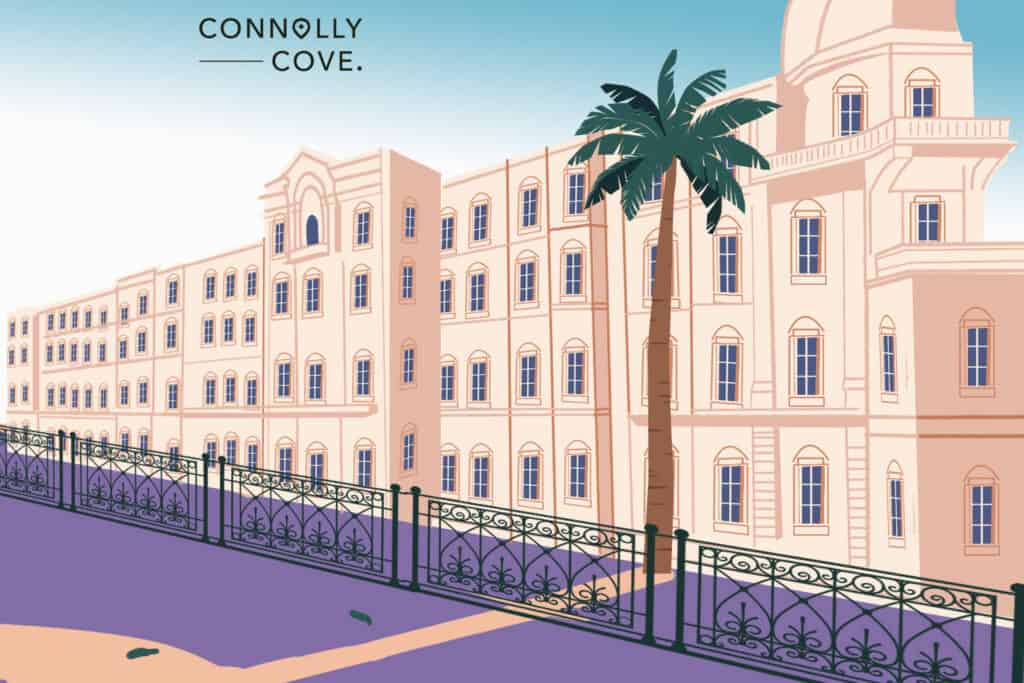Shepheard’s Hotel: How Modern Egypt Influenced the Success of Cairo’s Iconic Hostelry

Updated On: November 08, 2023 by Noha Basiouny
Almost two centuries ago, in al-Tawfikya, a very commercially active area in downtown Cairo now, there used to stand one of the most prestigious and luxurious hotels in Egypt and the entire world, the 19th-century iconic Shepheard’s Hotel.
Ever since it was built in the mid-1800s and until its unfortunate destruction in 1952, Shepheard’s Hotel gained fame for its hospitality, warm atmosphere, high-class service, and overall splendour and majesty. It was an architectural masterpiece in itself that both matched and inspired the modernity of the then-newly-born downtown Cairo.
Shepheard’s Hotel was the lavish residence of the Egyptian elite, tourists, and high-profile personalities, such as politicians, diplomats, and princes. Even Winston Churchill himself stayed there during his visit to Cairo in late 1943. The hotel was also an opulent military base for foreign officers and soldiers and a fantastic forum for scholars, writers, actors, and filmmakers.
Having been there during two of the most transforming centuries in modern history, Shepheard’s Hotel witnessed local and international events that helped shape Egypt as it is now and the world we live in today.
A little insight into 19th-century Egypt
To understand how Shepheard’s Hotel gained that much fame and what influenced its unequalled success, we need to go some 50 years back in time before its construction and look into what was going on in Egypt at the time.
For a lot was going on in Egypt at the time, and it was all initiated by the French.
French Campaign in Egypt
One day in 1798, in the aftermath of the French Revolution, Napoleon shouted out at his soldiers to board the ships as he, all of a sudden, decided to pay Mother Egypt a visit.
Upon his arrival in Alexandria, Napoleon quickly took over the city. But as he marched toward central Egypt, he wanted to appear as trying to keep his visit mild. He even went as far as falsely claiming he converted to Islam to deceptively convince the Egyptians he came in peace and not at all to plunder and pillage their country.
But the mild visit turned severely violent, a war basically, anyways.
If we take politics, violence, and all the French colonisation dreams out of the equation, the French campaign in Egypt was not all nasty as Napoleon did not come with lieutenants, soldiers, horses and weapons only. His campaign also included 160 scholars and scientists, known as Savants, as well as 2400 technicians, artists, and engravers. They were all assigned the sole objective of studying everything in Egypt.
So, they did.
The Description of Egypt
When Napoleon, secretly and cowardly, fled Egypt in 1799 after a series of defeats, his soldiers were still on the battlefield, wondering where their leader went. They apparently did not realise their campaign was a failure until two years later.
So those who survived, thankfully including the Savants, set off for France in 1801. Once they settled home, the Savants collected their writings, notes, illustrations and the knowledge they kept in their heads, buckled down, and started working on The Description of Egypt.
That description of Egypt, or description de l’Égypte if you want to sound prestigious, is a long series of publications that comprehensively demonstrate, describe, and catalogue everything about ancient and modern Egypt the Savants observed during their campaign. It included detailed information about Egypt’s history, geography, nature, society, religions, and traditions.
It took the Savants eight years to publish the first publication, which came out in 1809. More and more publications followed for the next 20 years. The first edition of The Description of Egypt included 23 books. However, the second edition was expanded into 37 books making The Description of Egypt the largest and most significant publication in the entire world at the time.
Deciphering the Rosetta Stone
Another breakthrough that the campaign of Napoleon influenced was the deciphering of the Rosetta Stone. For centuries after the end of the last Egyptian dynasties, around 30 BC, Egyptians were captivated by the legacy of their ancestors, from the pyramids, temples, and tombs, to the monuments scattered everywhere around the country.
And the pharaohs honestly saved no effort in telling their descendants about their civilisation and their outstanding achievements. They wrote everything, in tremendous detail, on papyrus paper, the walls of tombs and temples, obelisks, furniture and pretty much every rock they found. But there was a tiny problem. The descendants, the post-pharaohs Egyptians, did not really understand anything from those writings simply because they could not read the ancient Egyptian languages. As a result, the Egyptian civilisation remained a complete mystery for a really long time.
So what were these ancient Egyptian languages anyway?
Ancient Egyptians used four writing systems, which developed over thousands of years, the Hieroglyphs, Hieratic, Demotic and Coptic, with the last turning into the official writing system during the second century when Egypt was introduced to Christianity. When the Arab Muslims arrived in the country sometime in the seventh century, they brought Arabic with them. So after hundreds of years, all those ancient languages died out, and Arabic became and remains the official language to date.
When the French conquered Egypt, neither they nor the Egyptians knew more than a handful of information about the ancient civilisation. But this was meant to change when the French officer Francois Bouchard discovered the Rosetta Stone in 1799. The Rosetta Stone is a relatively large rock made of dark granite. It bears a text repeatedly written in three scripts: Hieroglyphs, Demotic, and Greek. The writings were a complete mystery until the French linguist Jean-Francois Champollion successfully deciphered them in 1822.
When Champollion successfully introduced what the Hieroglyphic letters really meant, the door to the full understanding of the ancient Egyptian civilisation suddenly became wide open. Such a breakthrough consequently paved the way for founding Egyptology, the scientific study of ancient Egypt in terms of history, culture and language. These insane French discoveries sparked Egyptomania, the mere fascination of everything about ancient Egypt which took the entire European continent by storm. It even crossed the Atlantic and contagioned the Americans during the 19th century.
As a result, Europeans and other foreigners started coming to Egypt to satisfy their mania. Mesmerised by Egypt’s great weather, fantastic culture, and terrific attractions, the Europeans became more and more interested in Egyptian history. Archaeological excavations swept the country, feverishly looking for pharaonic treasures. Speaking of that, one of the most remarkable discoveries was that of King Tutankhamun’s tomb, which was made by the British archaeologist Howard Carter in 1922 in the Valley of the Kings in Luxor.
Modern Egypt
Europeans were also struck by the new wave of modernity that started in the country a few years after the French left, which in return attracted more and more foreign interest.
In early 1801, Muhammad Ali rose to power and became the Ottoman ruler of Egypt. He had the vision to transform Egypt into a leading country. So he started a series of serious reforms in the economy, trade, and military, including weapons production, as well as considerable developments in agriculture and industry.
When Muhammad Ali died, the developments were continued by his successors, rising to the ultimate peak during the reign of Khedive Ismail the Magnificent, who ruled Egypt from 1863 to 1879.
Fascinated by European architecture, Ismail ordered the establishment of Cairo‘s iconic downtown in the same style. It was to be the privileged expansion to the capital, which Ismail wanted to be better than Paris itself. It was also during Ismail’s reign that the Suez Canal was opened, precisely in 1869.
Ismail was so obsessed with the economic developments and the urbanisation of Egypt that he took it too far, way further than Egypt could bear. Toward the end of the 1870s, Egypt fell into severe debt that forced the selling of the Suez Canal Company’s shares to the British, declaring bankruptcy, removing Ismail from power and sending him to exile in Ercolano, a town in Naples, Italy.
Shepheard’s Hotel

All of that combined created an atmosphere of prosperity and a growing interest in Egypt as a fantastic newly discovered destination with even more fantastic attractions. Aside from the severe colonial consequences this growing interest brought about, it highly contributed to the success of the mighty Shepheard’s Hotel and destined it for over a century of glory.
Birth
Shepheard’s Hotel was constructed in 1841 by the British entrepreneur and businessman Samuel Shepheard on a large piece of land in the al-Tawfikya area in Cairo. Shepheard was originally a clever pastry chef, but he decided to put his eminent business skills into practice during his stay in Egypt.
But Shepheard was not the sole owner of the hotel. He co-owned it with Mr Hill, Muhammad Ali‘s head coachman—this can give you an insight into how well-paid foreign people in Egypt were at the time.
Unlike the insanely encyclopaedic Description of Egypt that was completed 11 years before the hotel was established, there is no documentation of what Shepheard’s Hotel looked like or how big it was back in the mid-19th.
In 1845, Mr Hill withdrew himself as a co-owner of the hotel, leaving Shepheard to become the only possessor. Six years later, Shepheard himself sold the hotel to Philip Zech, a hotel owner from Bavaria, and went back to England to spend his retirement years.
Renovations
By the end of the 19th century, the European-styled downtown Cairo was already built around the same area where Shepheard’s Hotel stood. Compared to the modern city designed by the most skilful French architects, the hotel looked pretty outdated.
As a result, Zech decided to wreck the hotel and build a brand new one instead, with a more modern design and a much larger size. So, he hired a young German architect called Johann Adam Rennebaum for that very purpose, who did a great job in turning Shepheard’s Hotel into an architectural masterpiece.
The construction work ended in 1891, but Zech was way too clever to let the hotel go outdated again. So, renovations continued in the following years until 1927.
The new Shepheard’s Hotel was expanded several times. More wings with more and more lavish rooms with beautiful stained glass and stunning Persian carpets were added. The gardens were enlarged, and the terrace was turned into a unique forum for well-educated people and famous personalities.
The service was excellent, as described by many residents. The food was also reportedly fantastic, of a high-quality and terrific taste like that served in leading European hotels.
Shepheard’s Hotel was also known for its ‘long bar’, which was not long at all. Instead, it was described this way thanks to the long line of residents who stood every night in front of the bar waiting for a drink to loosen up.
When Zech died, his daughter and her husband became the new hotel owners. But they sold it in 1896 to Egyptian Hotels Ltd, which was, in fact, a British company. This company later leased the hotel to the Compagnie Internationale des Grands Hôtels to operate it.

Glory
Shepheard’s Hotel was destined for glory, gaining more fame from its high-profile guests. Many celebrities from different countries stayed at the hotel. British, French, Australian, and American soldiers resided there amidst World War I and World War II. This also labelled the hotel as a military base.
One interesting story that took place in the hotel was the creation of the famous cocktail, the Suffering Bastard, during World War II. At the time, the Nazis were doing really well on all their frontlines, and the Allied soldiers in Egypt were equally upset by the Nazis’ advancing and the absence of good alcoholic drinks on the battlefield! So, the bartender of the hotel invented that cocktail as a way to support them.
By that time, in the early 1940s, Shepheard’s Hotel was famous nationwide. Even the Nazi general Erwin Rommel, nicknamed the Desert Fox, who was already fighting in the northwest coastal city of al-Alamin, heard of Shepheard’s Hotel and promised to celebrate his victory by drinking champagne in its master suite.
But Rommel was never meant to keep his promise.
Fall
Unlike many establishments that lose their sound quality over time and begin the inevitable downfall, Shepheard’s Hotel’s end was instead a tumble.
Some residents reported the famous lavish quality of Shepheard’s Hotel was declining by the end of the decade. This could be related to the aftermath of World War II and the great economic depression affecting the hotel operating company. The political unrest in Egypt, which heated up in the late 1940s and the early 1950s, also contributed to the hotel losing some of its glory.
However, what really put a sudden end to Shepheard’s Hotel was the Cairo fire of 26 January 1952, which completely destroyed it. The impact of this event was so massive that a total of 750 buildings, shops, cafes, hotels, restaurants, theatres and cinemas were totally or partially damaged.
Modern Shepheard Hotel
In an attempt to restore the iconic Shepheard’s Hotel, a new one was built five years after its destruction. It was given the name Shepheard Hotel. For some reason, it was not built on the same land but rather at a location about one kilometre away, in the neighbourhood of Garden City. The modern Shepheard Hotel was utterly different from the first one in terms of the area, design, and architecture, which had nothing to do with the European style of downtown Cairo. The new hotel came out looking much like a modern boxy building, but it was privileged to oversee the River Nile’s dazzling water.
The new hotel also did so well and soon became one of the country’s most luxurious and leading hostelries. For over half a century, Shepheard Hotel provided fantastic residencies for tourists from all over the world. In 2009, a decision to renovate Shepheard Hotel was made. The project was awarded to the British Company Rocco Forte, which promised to reopen the hotel in 2014. But the plans were never executed, partially because of the Egyptian Revolution of 25 January and the political unrest that followed it. When it was finally clear that no work was to begin anytime soon, the hotel was temporarily closed in 2014 until better fate waves on the horizon.
It was not until six years after that, while the hotel was still standing patiently and probably getting sickeningly bored of watching sunrises and sunsets over the Nile, the Egyptian General Company for Tourism and Hotels (EGOTH) came to an agreement with the Saudi company AlSharif Group Holding to finance the renovation of the hotel. That said, the hotel apparently turned out to be just as unlucky as Scrat from the film franchise Ice Age as the contract was signed only two weeks before the outbreak of the coronavirus. Due to the lockdown, the renovation work was slowed down, if not paused completely.
In February 2023, the final contract between the two parties, the Egyptian and the Saudi, was signed with the Hong Kong investment company Mandarin Oriental Hotel Group to take care of the management. Shepheard Hotel is set to reopen as a luxury five-star hotel in 2024.
Downtown Cairo is the heart of the city and the beloved hub for all Egyptians and especially Cairenes. If you ever make it to Egypt, which we hope you do, make sure you visit these legendary attractions in downtown Cairo if you want to make your trip a never-to-forget experience.






